After the LFP made their decision to abandon this season’s Ligue 1 and Ligue 2 football and confirmed that the final standings will be decided on points-per-game average, Lorient (alongside Lens) are automatically promoted back to the top-flight having topped the Ligue 2 table after such an impressive season. Meanwhile, PSG retained their title yet again after being declared the champions while Marseille and Rennes finished second and third respectively, being in line for UEFA Champions League next season.
After missing out on the automatic promotion as well as the playoffs spot last season, Lorient appointed new manager Christophe Pélissier to take over the team for this season. That proved to be a smart decision from the team as the former Amiens boss (who brought Amiens up to Ligue 1 in 2016/17) managed to quickly implement his playing style in an already strong Lorient side. The question now is, “will they stay in Ligue 1 by the end of next season?”.
This time we’re going to take a good look at Pélissier’s tactics and philosophy at Lorient through an in-depth tactical analysis.
Commonly-used formations

This season Pélissier has used a variety of formations in a game, but he mostly doesn’t stray far from 4-2-3-1 or 4-4-2. Occasionally, they can be seen starting with a 4-1-4-1 or a 4-3-3 as well and on some rare occasions, they can be seen using a 5-4-1 as well. Regardless of the formations he uses, the tactics and philosophy are pretty much the same in every game although depending on the opposition they’re facing, there may be one or two tweaks in the tactics in order to adapt to their opposition’s playing style.
With that said, the team shape may be quite flexible when in a match depending on the phase of play they’re in and where the ball is. This will be explained in more detail in the next sections of this tactical analysis.
Possession-based approach
Pélissier’s Lorient mainly look to play from the back and maintain possession whilst slowly working their way out of pressure and progressing forward with the ball. They’re clearly a patient, possession-based team that mainly use short-medium combinations in the game rather than playing with direct long balls forward. They rely on fluid and flexible structure in attack, with players often swapping positions and actively moving around to find or even create space to exploit.
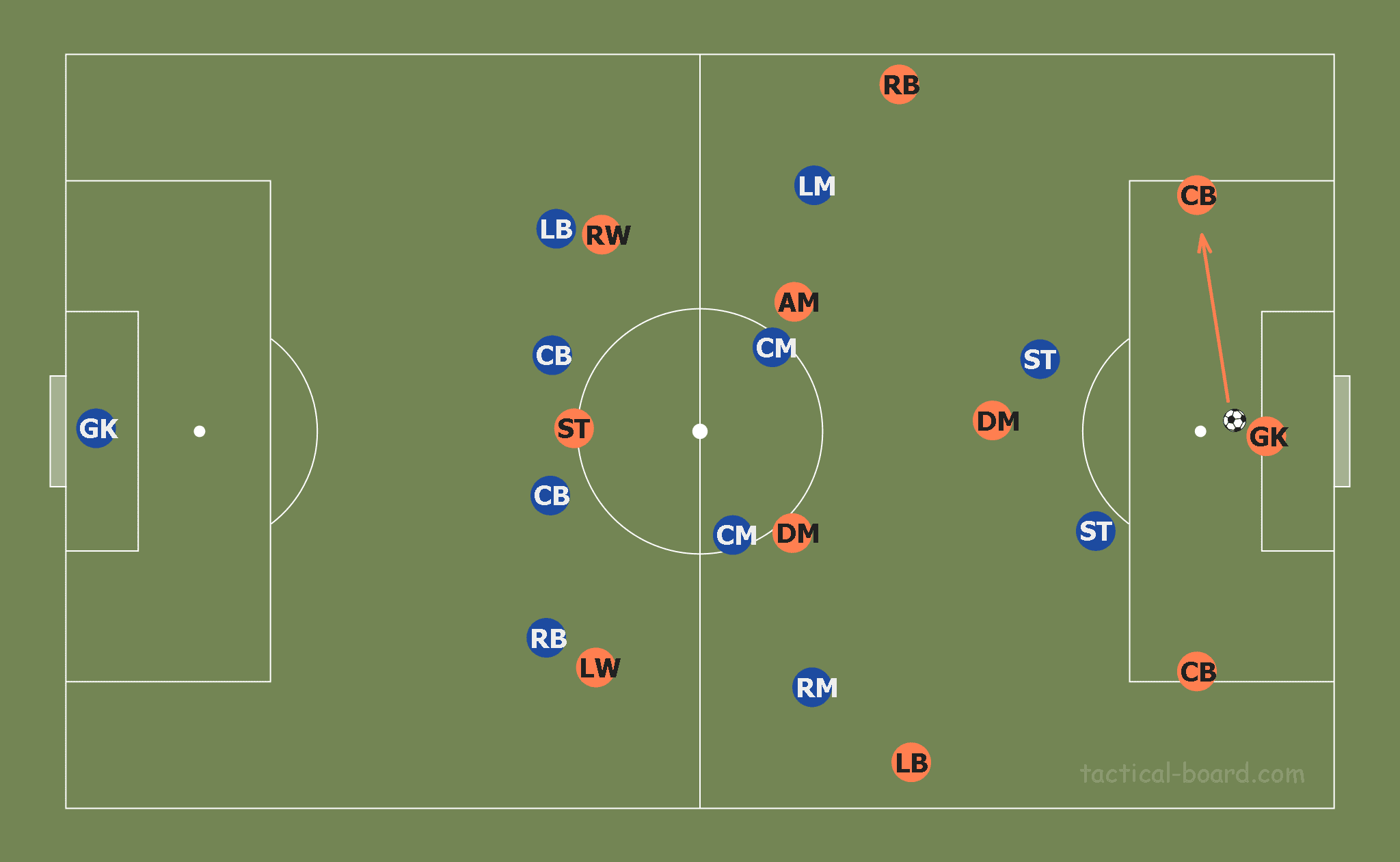
Lorient mainly start the build-up with a short distribution from the goalkeeper towards either of the two centre-backs. As you can see, the two centre-backs split wide while one of the two pivots (assuming they’re playing in a 4-2-3-1 formation in this game) stays deep while the other one sits slightly higher alongside the attacking midfielder who tends to drop slightly from his position and sit around the half-space. The full-backs usually start a bit high but will quickly drop whenever central options are blocked and the backline desperately needs some support to get out of pressure.
Against teams with highly aggressive frontline pressing, the goalkeeper may get involved more in the build-up to add to the number and provide support as well as help relieve pressure and maintain possession, creating what looks to be a diamond shape at the back. This is why having a goalkeeper with at least a pretty decent ability on the ball and passing in open play is quite necessary for Lorient and indeed they do have that kind of goalkeeper in former Monaco man, Paul Nardi.
Sometimes, playing out from the back is deemed too risky, so long distributions from the goalkeeper can also be seen at times. An example of this can be seen in the picture below.
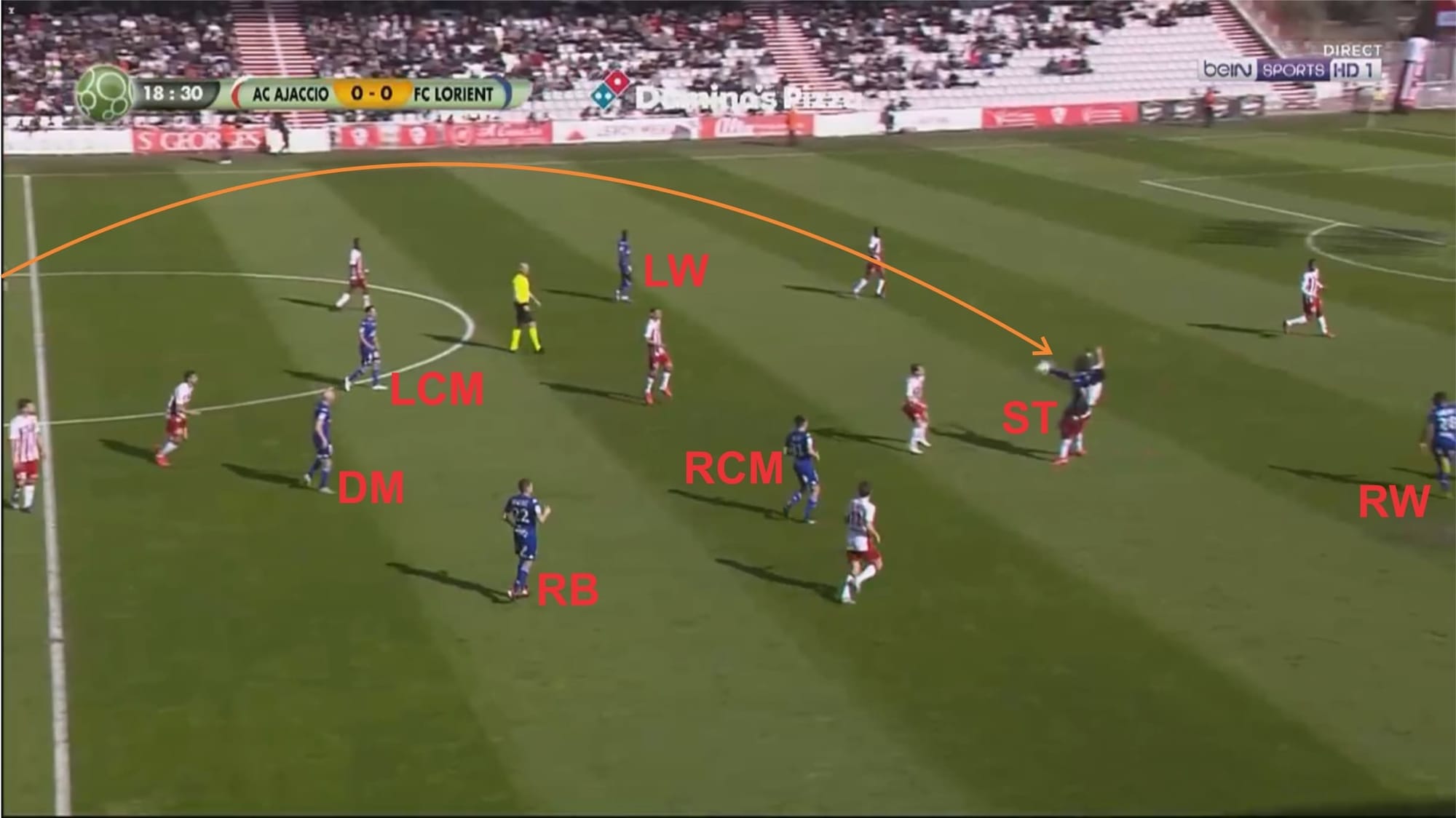
Above you can see how Lorient set themselves up to receive the goalkeeper’s long distribution. As you can see, Lorient are well-structured and well-prepared when it comes to winning second balls in the midfield. They’ll look to concentrate their players in one area, all of them staying close to each other. The striker is usually is the main target when it comes to aerial duels. The players around him are ready to receive the layoff if the ball is won by the target man or press if the target man lost the duel.
Against teams who are less aggressive in pressing and prefer to defend with a mid or low block, Lorient have the tendency to create a three-man backline when playing from the back in order to create a numerical advantage as well as ease circulation at the back. An example of this can be seen in the image below.
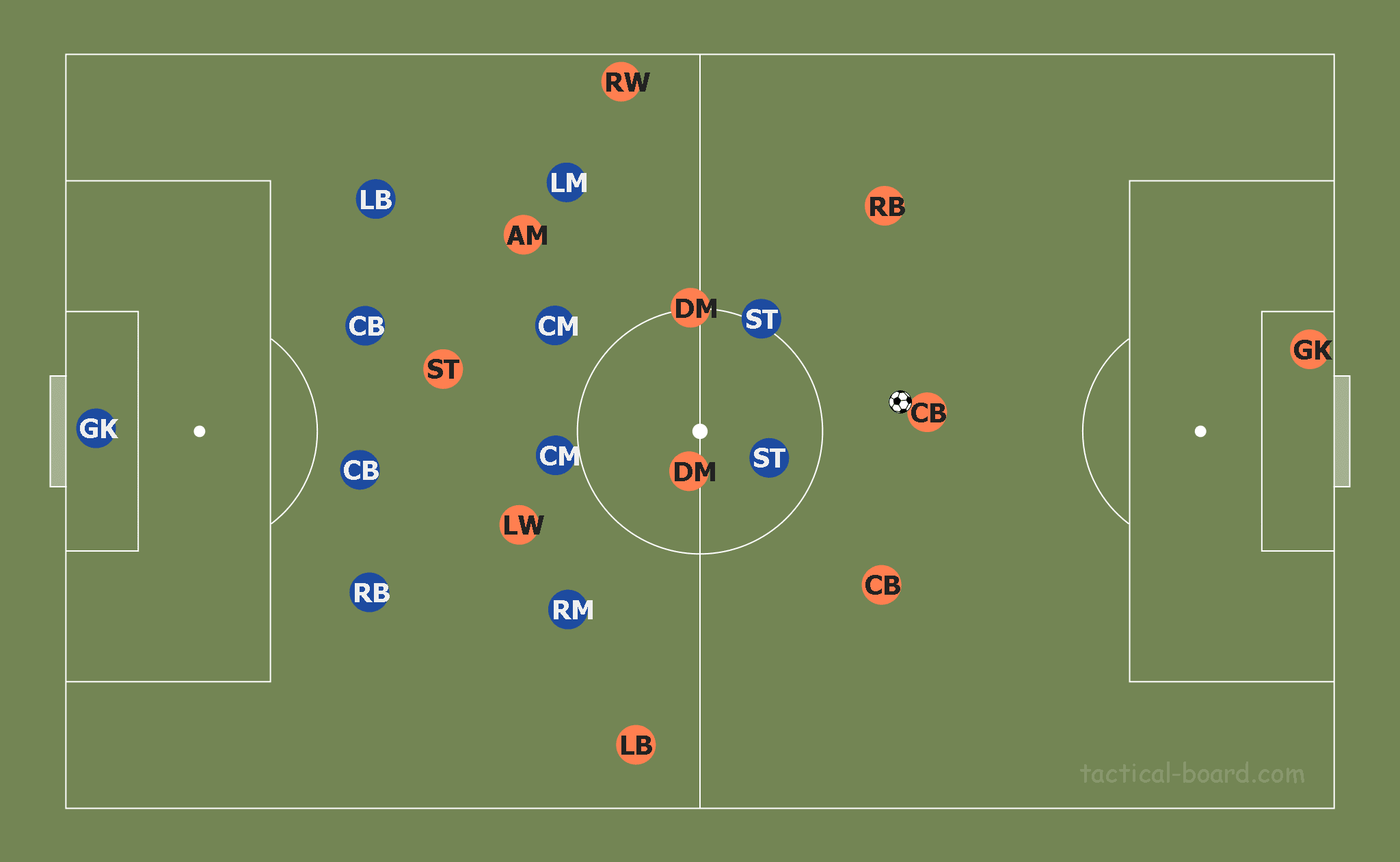
When creating a three-man backline, there seems to be no set rule as to who assumes the third “centre-back” position as either one of the two full-backs or defensive midfielders may drop and sit in between or beside the two centre-backs.
At times, one of the full-backs will stay low and sit beside the two centre-backs while the two pivots sit in front of the backline which you can see in the image above. The two full-backs are asymmetrical with one staying deep and the other one stretching wide and sitting quite high. Consequently, the two wingers are also asymmetrical with one stretching wide, sitting only just above the halfway line, while the other one sits in a pocket of space between the opposing midfield and defensive line, occupying central spaces instead.
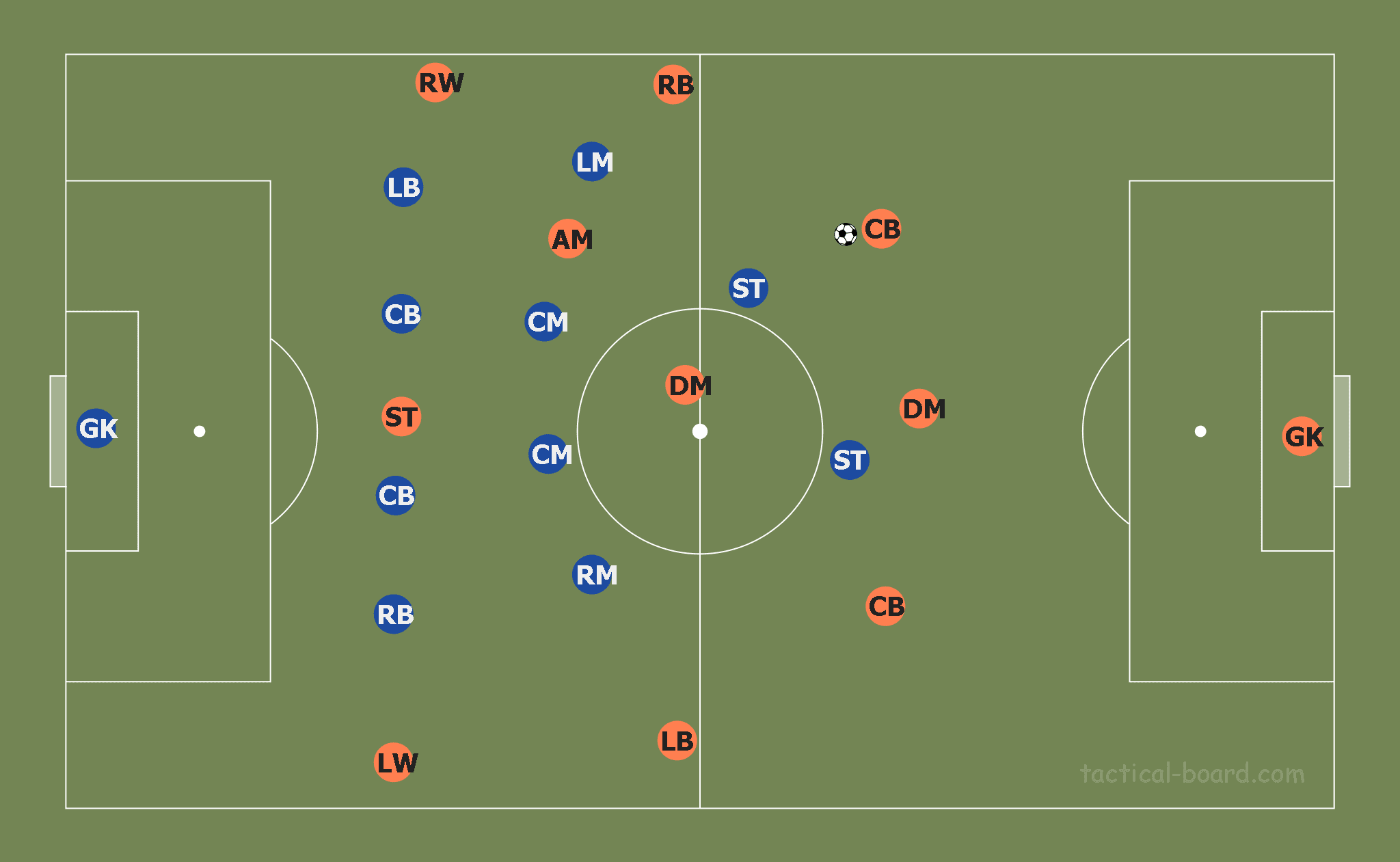
Some other times, one of the two pivots drop instead of the full-back which creates the shape which you can see above. One pivot drops deep and sits in between the two centre-backs while the other one sits alone in front of the backline. By dropping and sitting in between or beside the two centre-backs, the defensive midfielder is able to get out of the opposing team’s shadow cover and create a numerical advantage at the back (3v2).
The attacking midfielder is very flexible and dynamic and always moves around mainly looking to receive in pockets of space in between the lines but they can often be see roaming wide or often also dropping deep to offer support. Mainly, of course, the attacking midfielder will look to offer support in the half-space, making himself available as a passing option to help the team progress the ball and exit pressure.
You can also see the two wingers initially start wide in the picture above. However, they will usually move narrower and sit in the half-spaces or even occupy central areas meanwhile the full-backs tend to stay wide and make overlapping runs often. In both pictures, you can also see that the striker mainly sits centrally. However, his positioning and movements are rather dynamic and he can often be seen roaming wide and dropping deep. Often he can also be seen swapping positions with one of the wingers as you can see in the image below.
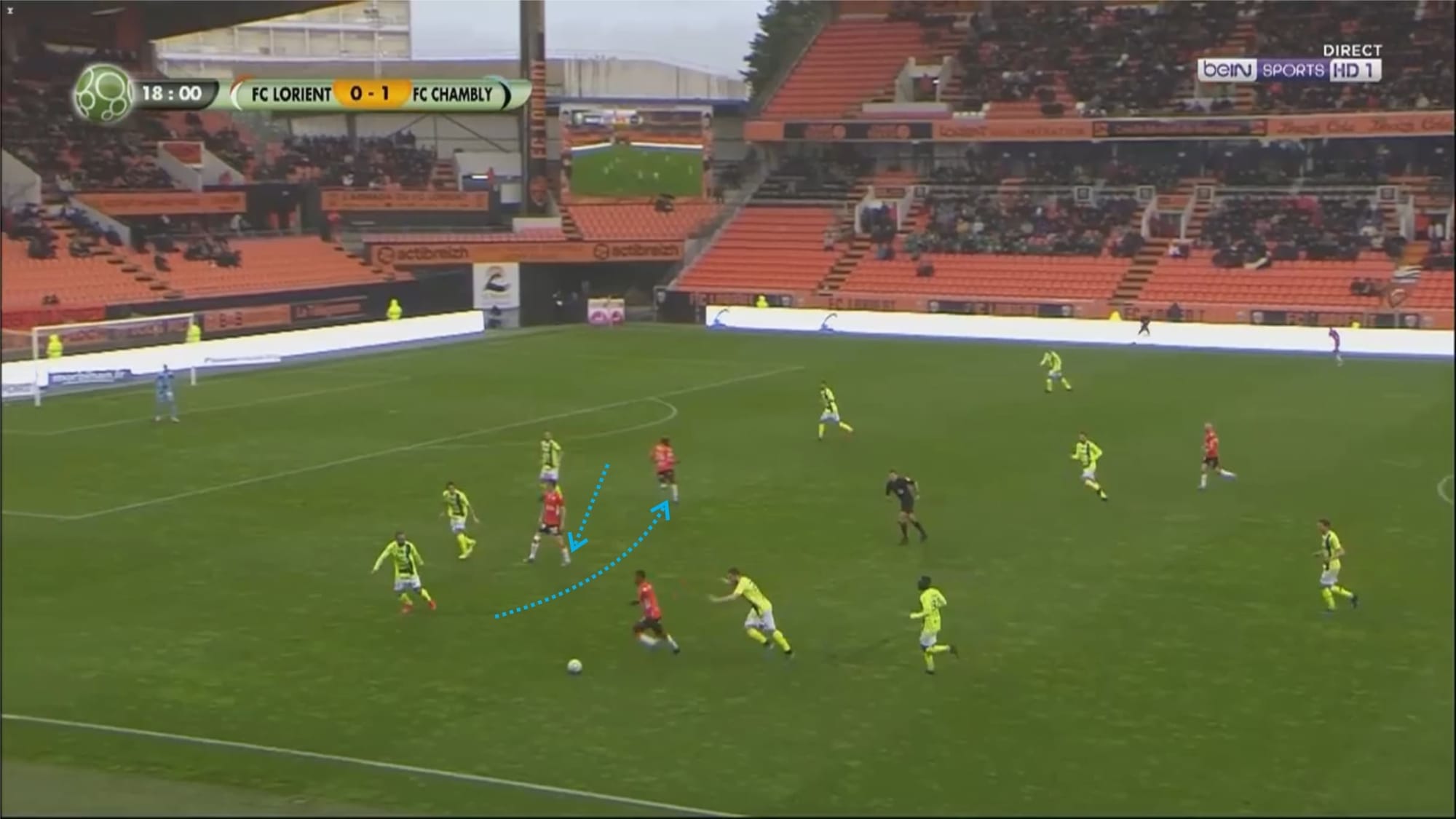
As mentioned earlier in this section, Lorient are patient and possession-based. They’ll look to play the ball around, trying to attract pressure and disrupt the opposing team’s structure to create openings. They never really rush to attack when in possession. Whenever they’re stuck, they’ll move the ball back, restructure, and restart as opposed to forcing their way in and just pumping the ball into the box. With that said, it doesn’t necessarily mean that they rely solely on safe passing and lacks creativity as their players can often be seen improvising and taking risks by playing difficult passes or even having a go from long-range.
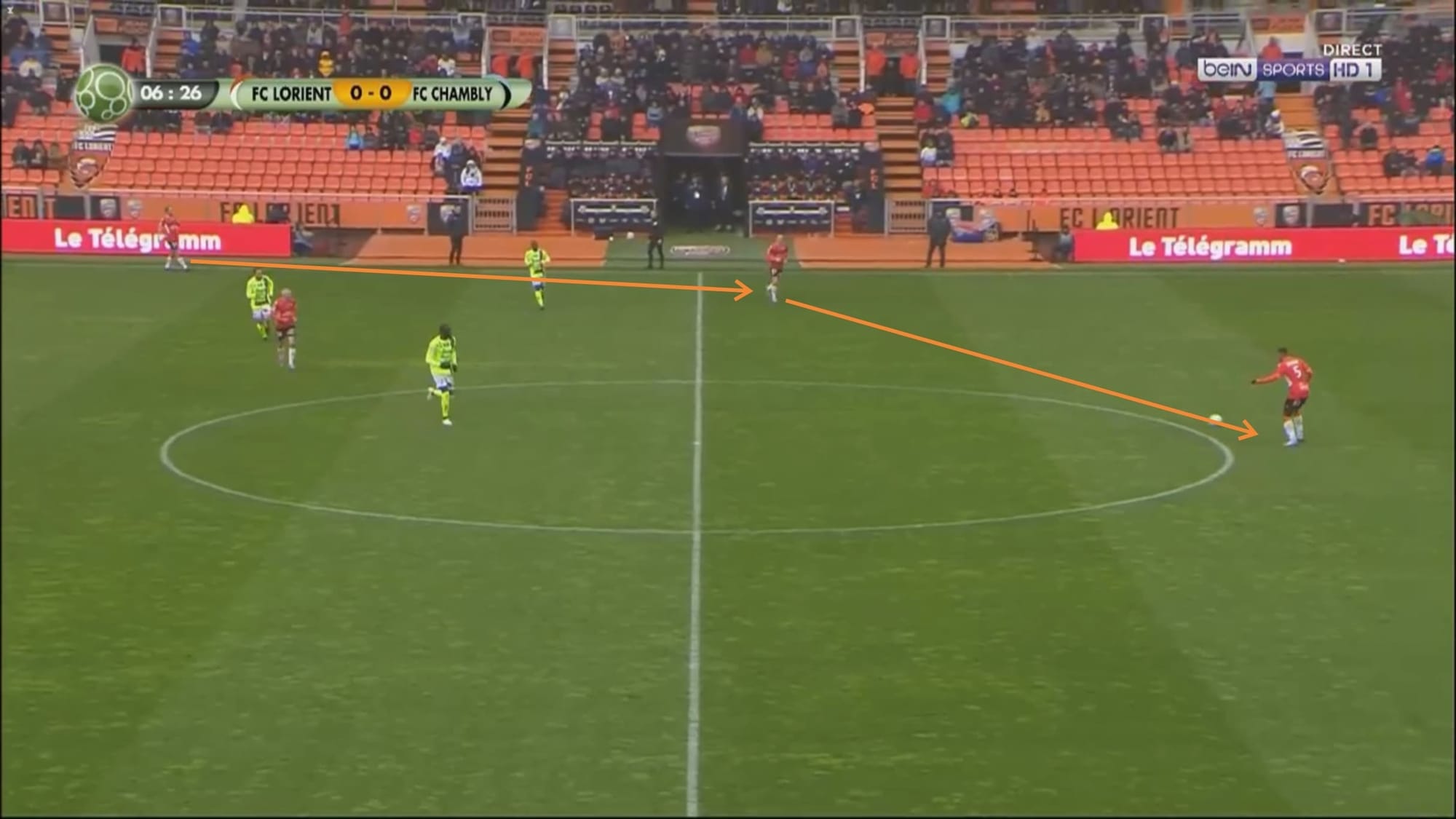
In the image above you can see an example of Lorient playing the ball backwards and restarting the attack. The right-back failed to find any spaces to exploit or good options to pass to and decided to play the ball back towards the right-sided centre-back, who in turn, played the ball into the feet of the left-sided centre-back.
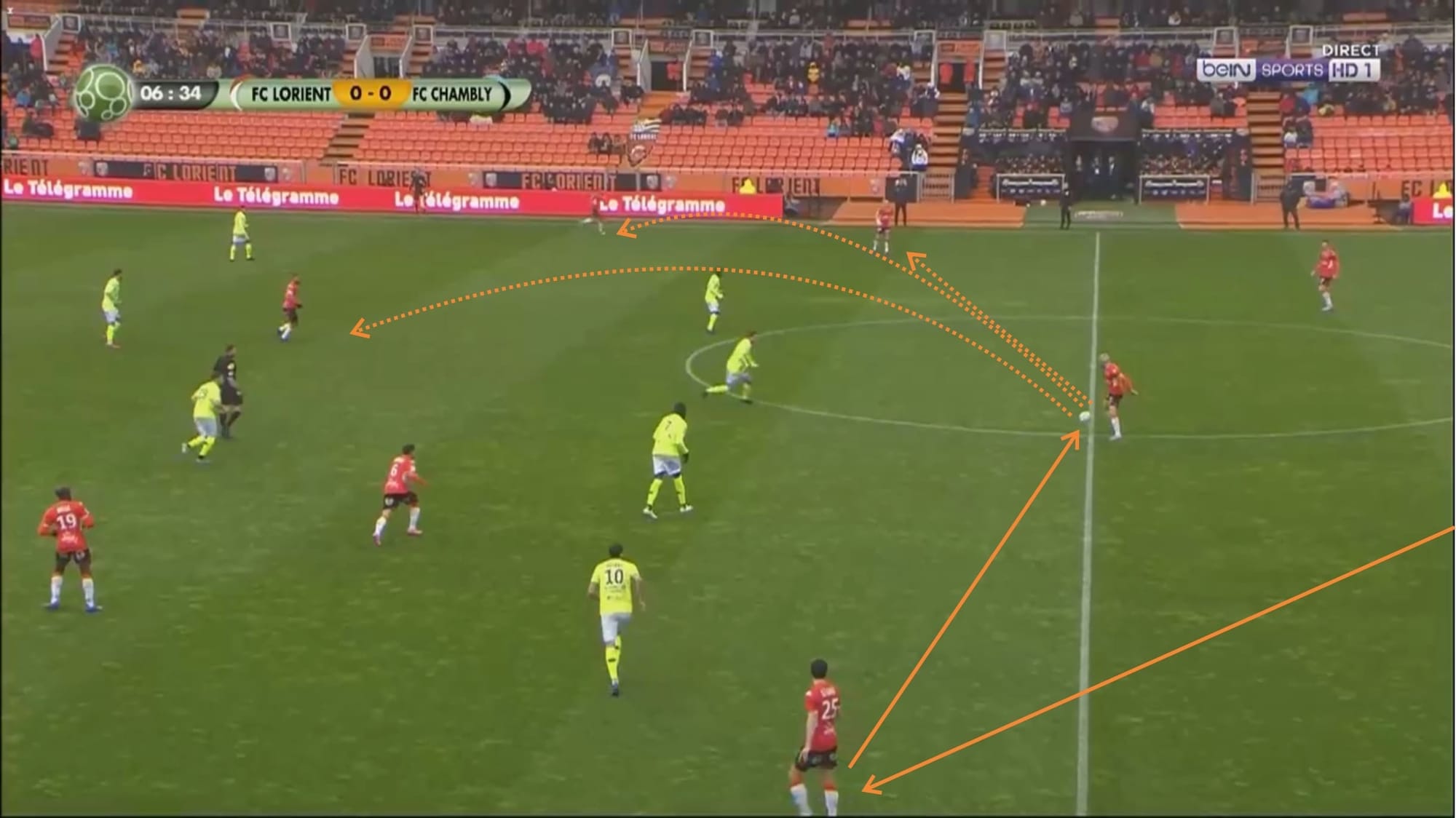
The left-sided centre-back then played the ball towards the left-back, completing the switch play and starting the attack once again. The left-back, in this case, had several options. He could have continued the play down the left flank as he received support from the left-sided defensive midfielder and left-winger who both moved closer to him to make themselves available as passing options. However, the left-back passed the ball towards the right-sided defensive midfielder again as you can see in the picture.
As you can see, upon receiving the ball, the defensive midfielder had several good options to play the ball to. He could play it towards the attacking midfielder who sat in between the midfield and defensive lines or he could play it wide towards the right flank again, forcing the opposing team to move their block once again.
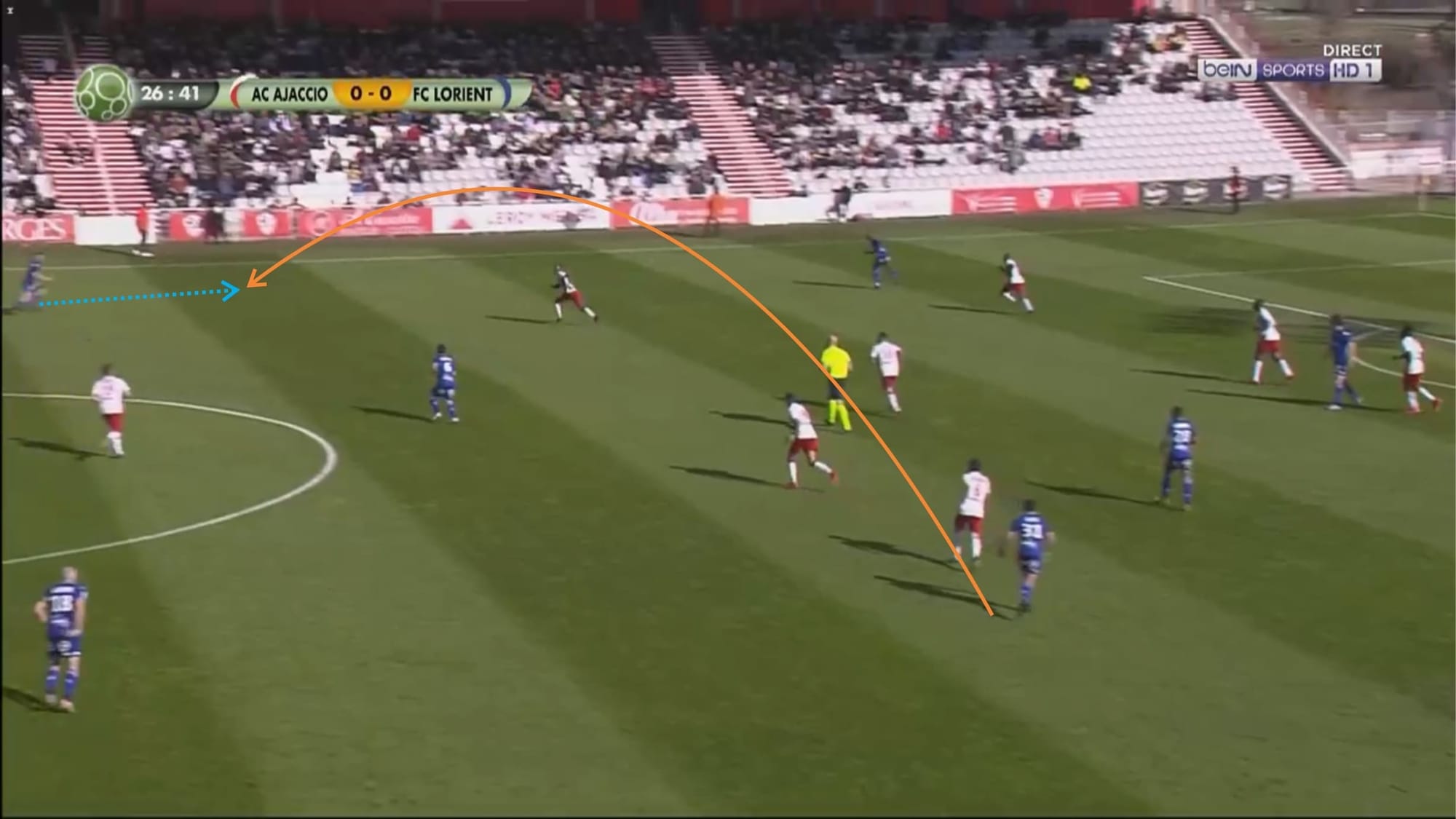
Though Lorient mainly will look to switch play using short-medium passes in what looks to be a U-pattern and play around the block, sometimes they’ll also look to switch play with long lateral or diagonal passes towards a teammate in an underloaded area although this doesn’t happen as often. Above, for example, you can see the right-sided central midfielder of Lorient playing a long pass into space in front of the left-back, inviting him to go forward and join the attack while also forcing the opposing players to switch the focus towards the other side of the pitch and move their block.
Lorient mostly will look to take advantage of the width of the pitch when in possession. They mostly look to progress and create in the half-spaces and wide areas. Once they move the ball towards the flank, they will concentrate their players in that position in order to create an attacking overload and a numerically superior situation. This can be seen in the illustration below.
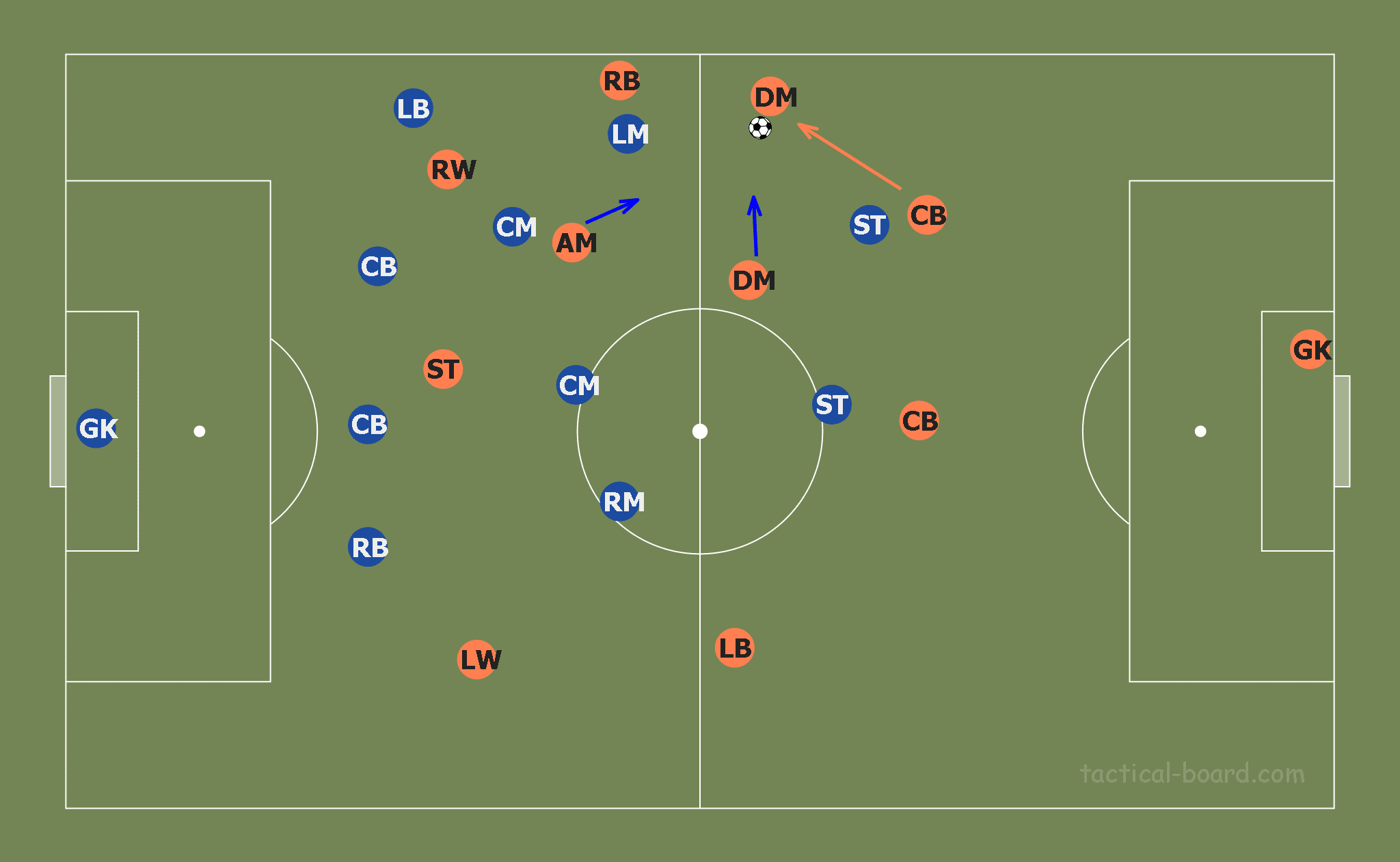
Above you can see their structure in the build-up and their attempt at overloading the ball-near area in order to create numerically superior situations. In the situation above, the right-sided defensive midfielder moved wide and dropped to receive a pass from the centre-back, allowing the right-back to stay a bit higher. You can also see the left-sided defensive midfielder and the attacking midfielder moving closer to the ball carrier, offering support.
By overloading one area of the pitch, Lorient also look to invite pressure towards that area. With the opposite winger and full-back looking to stay wide and stretch the opposing defence, Lorient may have one or two spare men in an underloaded area which could give them advantages in attack if they can switch play quickly and successfully.
We can see their passing pattern as well as players’ positional tendencies in the pass maps below.
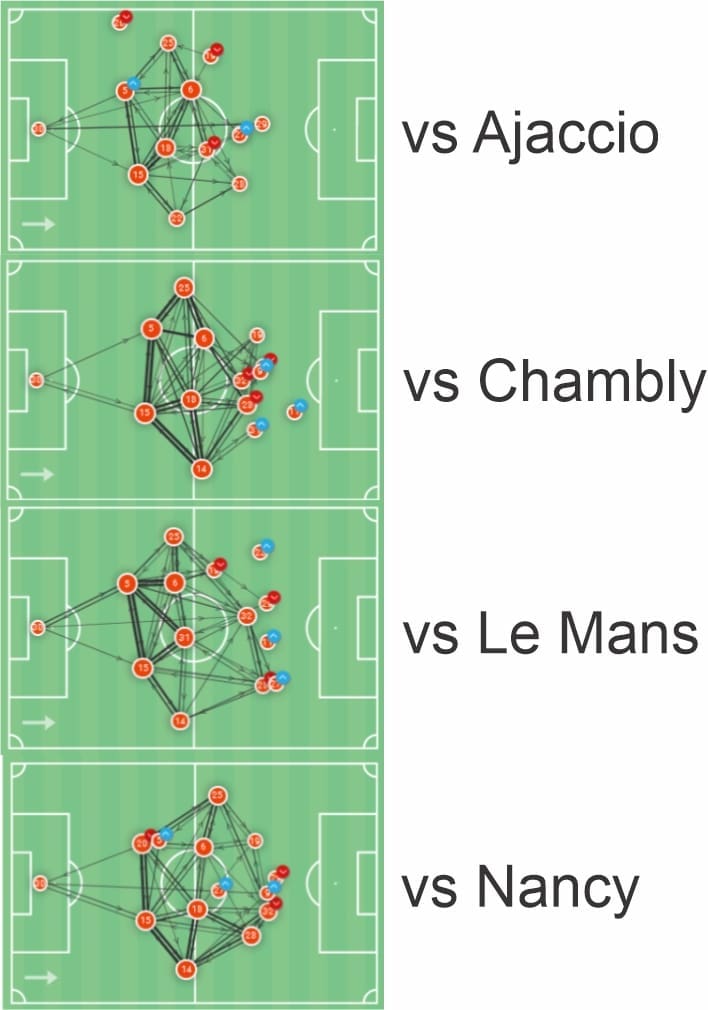
You can see in the pass maps above that Lorient play the ball at the back a lot. You can see them playing a lot of lateral passes around the back and the two centre-backs have the tendency to play the ball towards the ball-near full-back instead of the two pivots in front of them. However, in a match against Le Mans you can see that the centre-backs tend to play the ball towards the two pivots more often than the ball-near full-backs. This is because the two pivots were not marked tightly and were given a lot more freedom by Le Mans but instead they focused more on preventing passes towards the ball-near full-backs, hence the centre-backs were more comfortable playing the ball towards the two pivots.
Above you can also see the average positioning of the players. Both full-backs are quite wide as they can be seen stretching the opposition defence by sitting near the touchline and making overlapping runs out wide. But you can see that their positions are slightly asymmetrical which makes sense as one of them tends to drop more frequently to create three-man backlines which have been mentioned previously in this analysis (hence also the thicker passing lines). Both wingers tend to stay narrow and sit in the half-spaces while the striker mainly stays centrally.
You can see in the pass maps above that Lorient tend to combine and progress through the half-spaces and wide areas. They also create most of their chances from the half-spaces and wide areas either via crosses, inward through passes, or direct dribbles into the box. Lorient have an average of 16.03 crosses per game which is the third-highest number in the league. Their success rate of 29.1%, however, ranks 16th in the league which is pretty strange considering they score a lot of goals and create a lot of chances from crosses either crosses from deep, from the byline, cutback crosses and etc. The types of crosses and the target area also seem to vary but medium-height whipped crosses seem to be more frequent compared to floating or low crosses. The ball arriving at far-post also appears to be quite frequent compared to at the centre of the box or at the near-post.
High press and proactive defending
Lorient rely on high intensity and aggressive frontline pressing supported with a high defensive block in defence. They mainly look to stay narrow and compact and will move the block according to the position of the ball. Overall they are quite disciplined in defence but there are also several potential downsides that can be seen in their approach.
There are several common shapes that they take on when in defence.
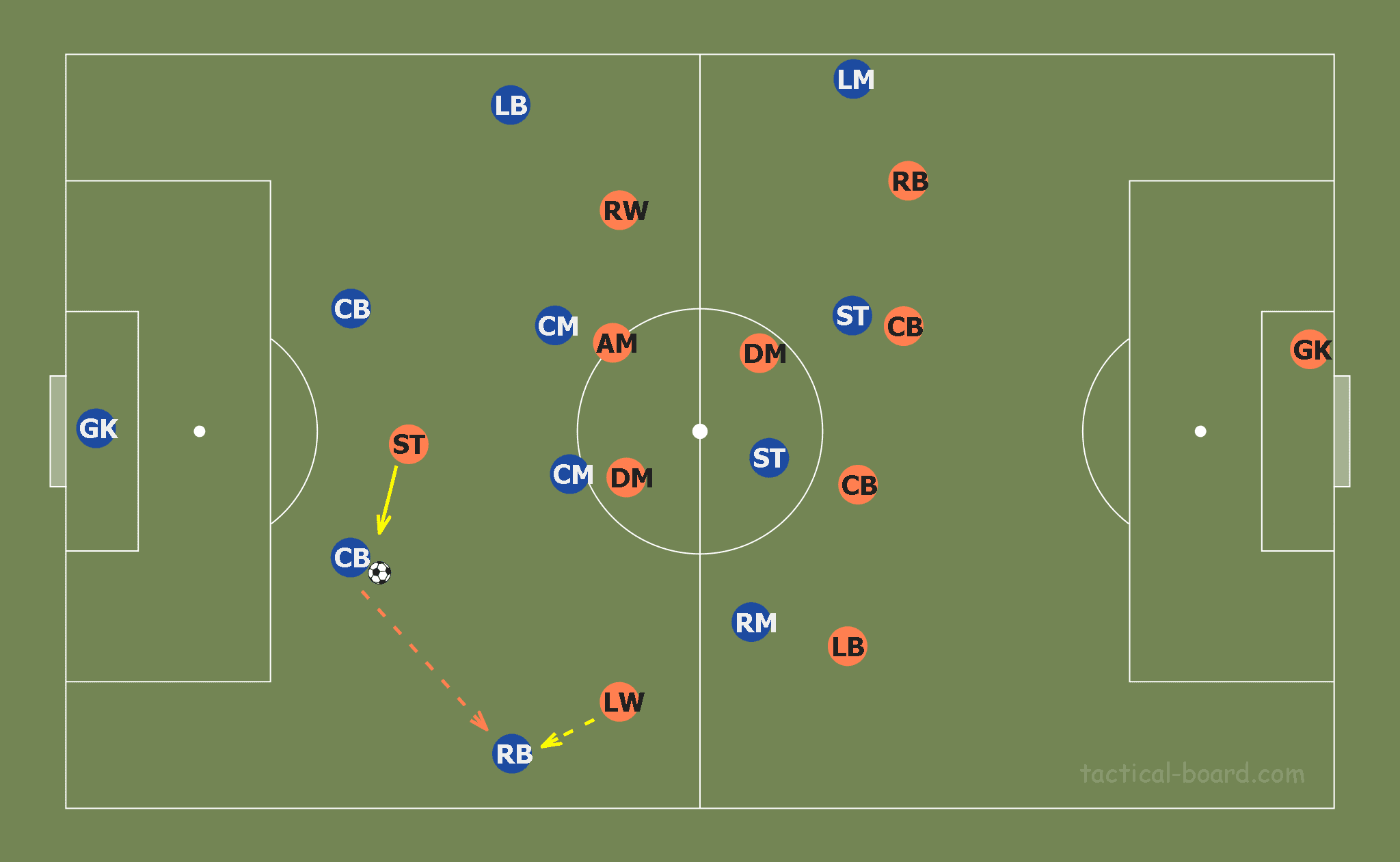
In the image above, you can see that Lorient defend with a 4-1-4-1 high block with the lone striker pressing aggressively and looking to split the two centre-backs and steer the ball carrier out, tightening his space and limiting his options. You can see Lorient’s left-winger moving close to the opposing full-back. Though the winger doesn’t stay very tight, he’s at least close enough to the opposing right-back to make the ball carrier think that he can’t pass there.
Lorient’s main idea of defending from the front is basically to prevent the team from playing from the back and force them to play long. They are vertically compact and well-structured which massively helps them when it comes to winning second balls in the middle third. They are also both option and passing lane-oriented in marking as you can see in the illustration above. The opposing ball-carrier may choose to play long or play the ball back to his goalkeeper. If the ball is played back to the goalkeeper, Lorient will push forward and pile more pressure whilst also blocking any near options to prevent playing from the back. In the end, opposing goalkeepers will opt to loft the ball long to get out of pressure.
However, as you can see in the illustration above, sometimes passing lane towards the half-space may open and the opposing wide midfielder may drop to receive.
If that happens, then Lorient’s players will quickly collapse onto the ball and compress space, creating a central pressing trap to destroy the opposition attack and win the ball back.
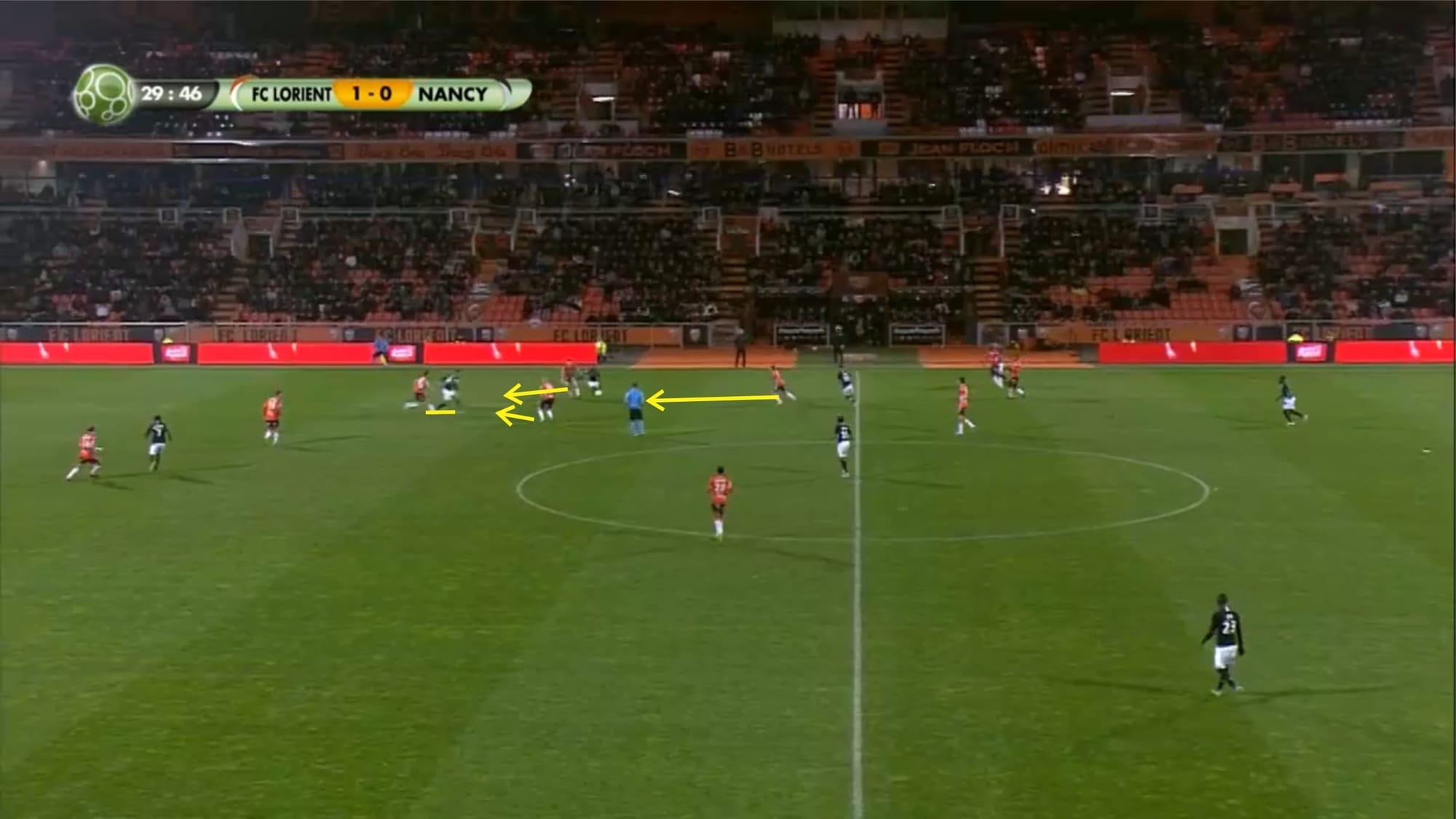
Above, for example, you can see the Lorient players immediately collapsing onto the ball and swarming the ball carrier after a pass was made by the opposing right-sided centre-back towards a wide midfielder in the half-space. The pass did find its intended target but with the ball receiver having nowhere to go, no space to turn, and simply no time to think and make his decision; he immediately lost the ball and Lorient then quickly started their counter-attack.
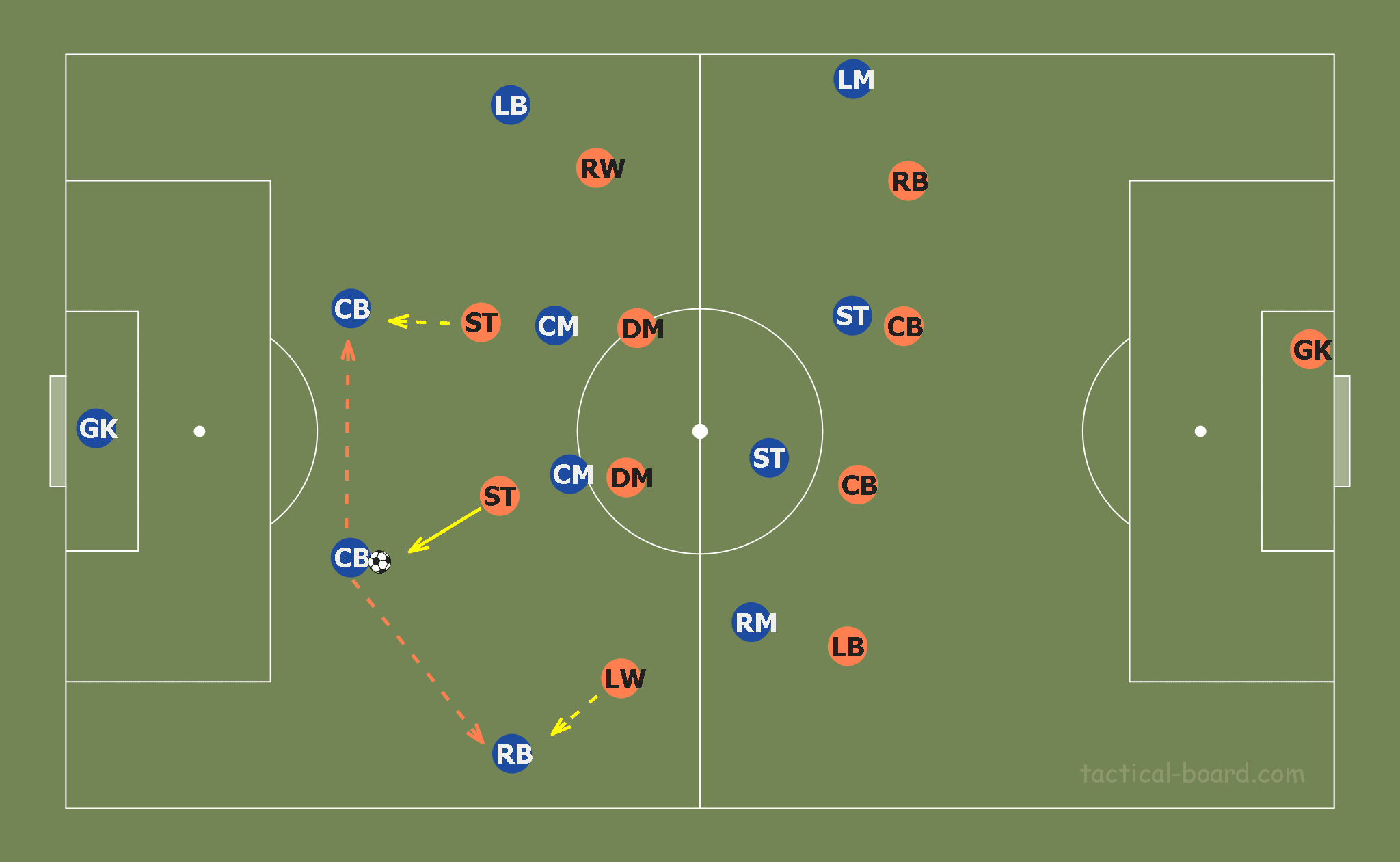
Another shape that they may take on in defence is a 4-4-2 shape as in the image above. The main aim is pretty much still the same: prevent them for playing from the back by cutting off options and force them to play long. What’s different is that the strikers don’t look to split the centre-backs. As you can see, the ball-near striker will look to press the ball carrier. Meanwhile, the other striker and the left-winger prepares to press whenever the ball is played towards their respective man. Again, the ball-carrier may choose to play long directly or play the ball back to the goalkeeper where they will be met with even more pressure by Lorient who’ll look to push up when a backwards pass is played. Of course, the ball carrier may also play the ball towards the player in the half-space which will trigger Lorient’s central pressing trap.
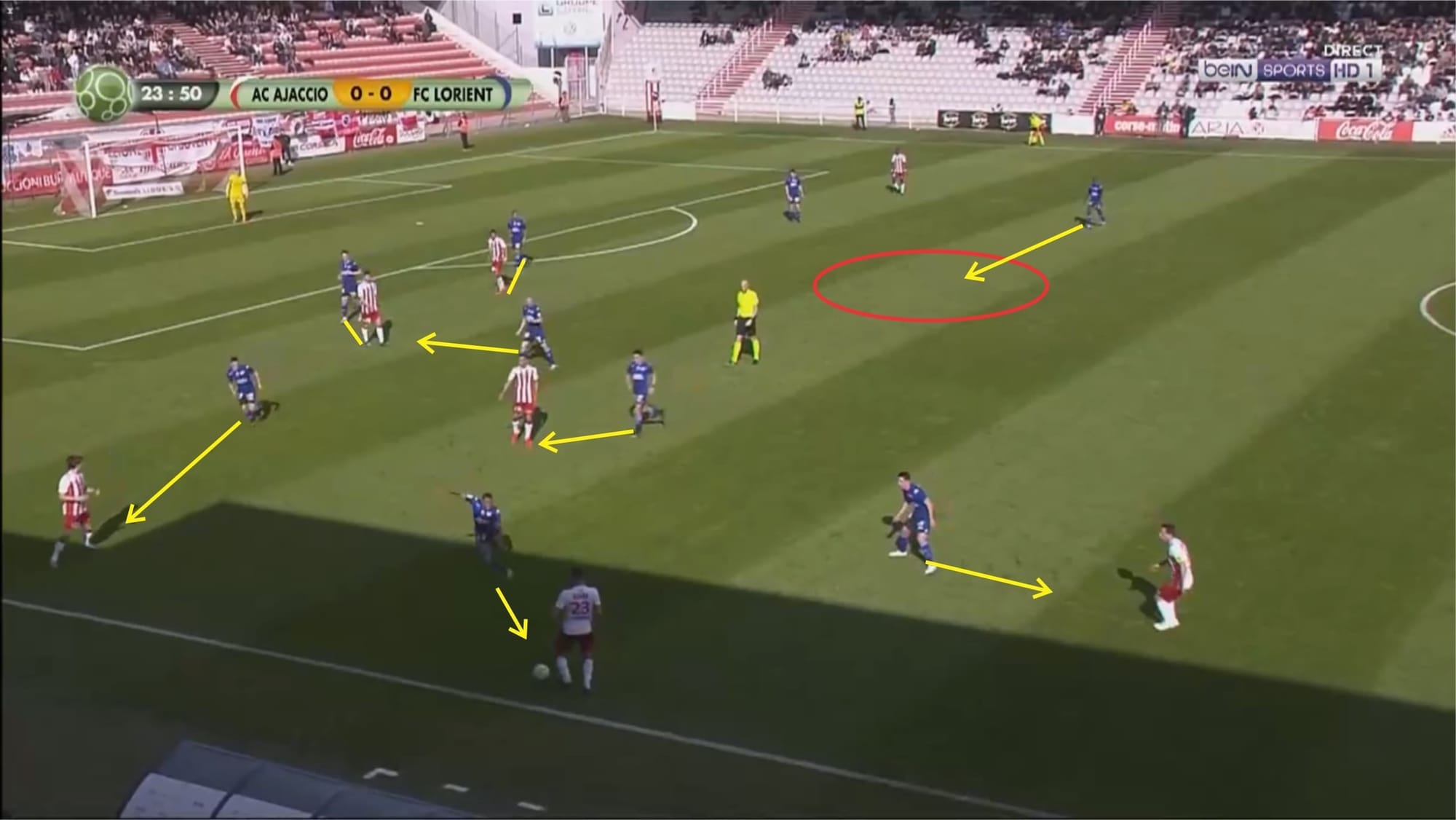
When the ball is on the flank, Lorient will quickly move their block and create an overload on that area. They’ll look to concentrate most of the players on one side of the pitch and try to gain a numerical advantage as well as isolating the ball carrier by cutting off his options. Above, you can see that even the left-sided central midfielder of Lorient moved the right side in order to overload the right half of the pitch. However, by doing so, they’re also leaving a gap in a certain area of the pitch which can potentially be exploited by the opposing team. Due to this, Lorient’s left-winger which you an see in the image above will move to cover the space.
Lorient’s vertically and horizontally compact defence may give them a lot of advantage in defence and can make it very hard for opposing teams to progress and attack them. However, they require very high discipline, especially when moving the block in order to ensure the chain is well-connected and to prevent gaps/openings in the channels.
Quick to start and even quicker to delay
When it comes to transitions, Pélissier’s side are very quick. Lorient are proficient in both executing quick, dangerous counter-attacks and effective counter-pressing to delay or win the ball high up the pitch.
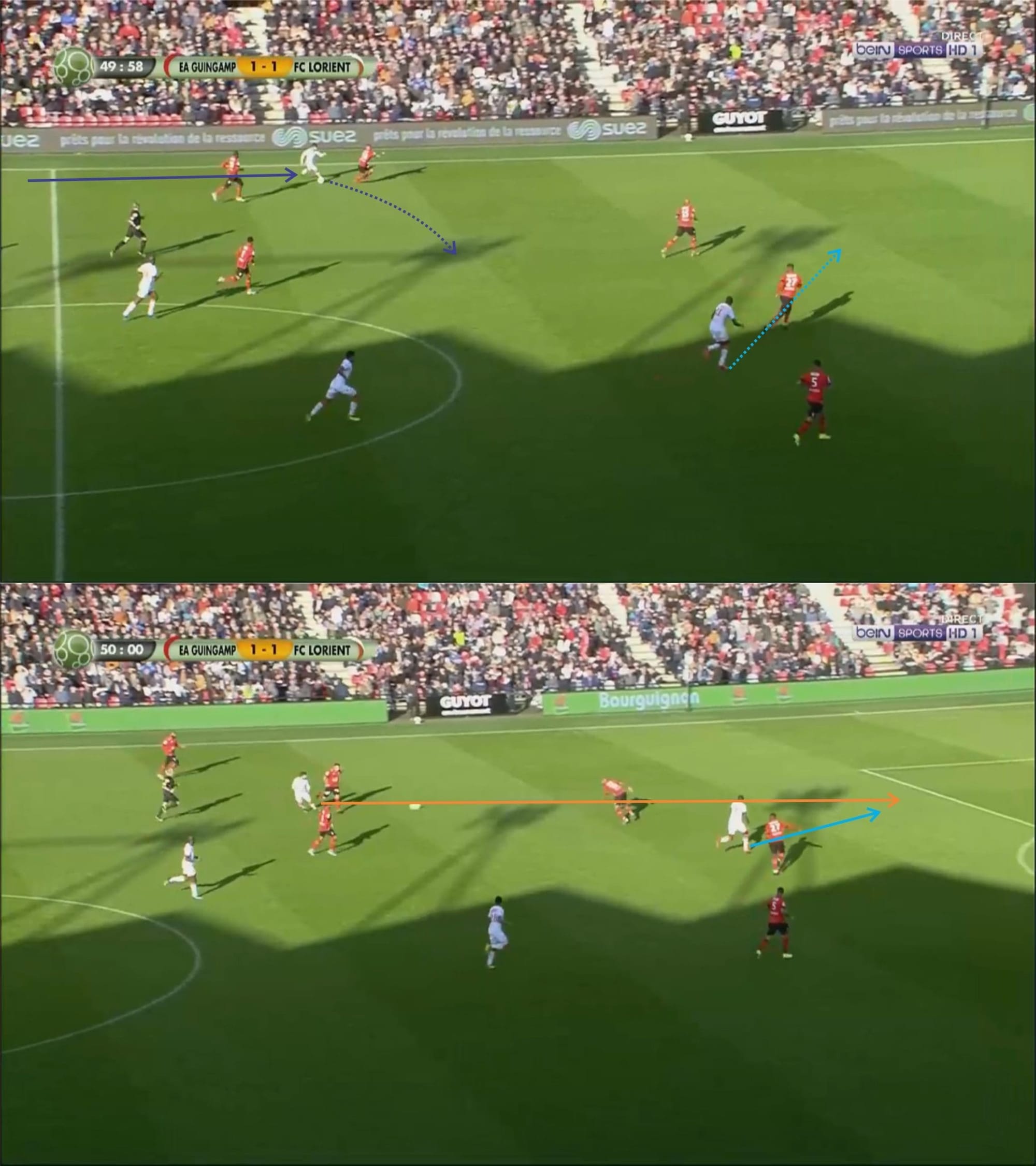
Every time they win back possession, players will quickly make runs forward. The type of counter-attack may vary though depending on who carries the ball after winning possession. While playmakers like Fabien Lemoine, Laurent Abergel, and Enzo Le Fée who have great vision and high confidence and proficiency in passing will prefer to play long, direct passes into space; pacey dribbles like Yoane Wissa, Armand Laurienté, and Cabot mainly prefer to drive forward with the ball before releasing a through pass which you can see in the image above.
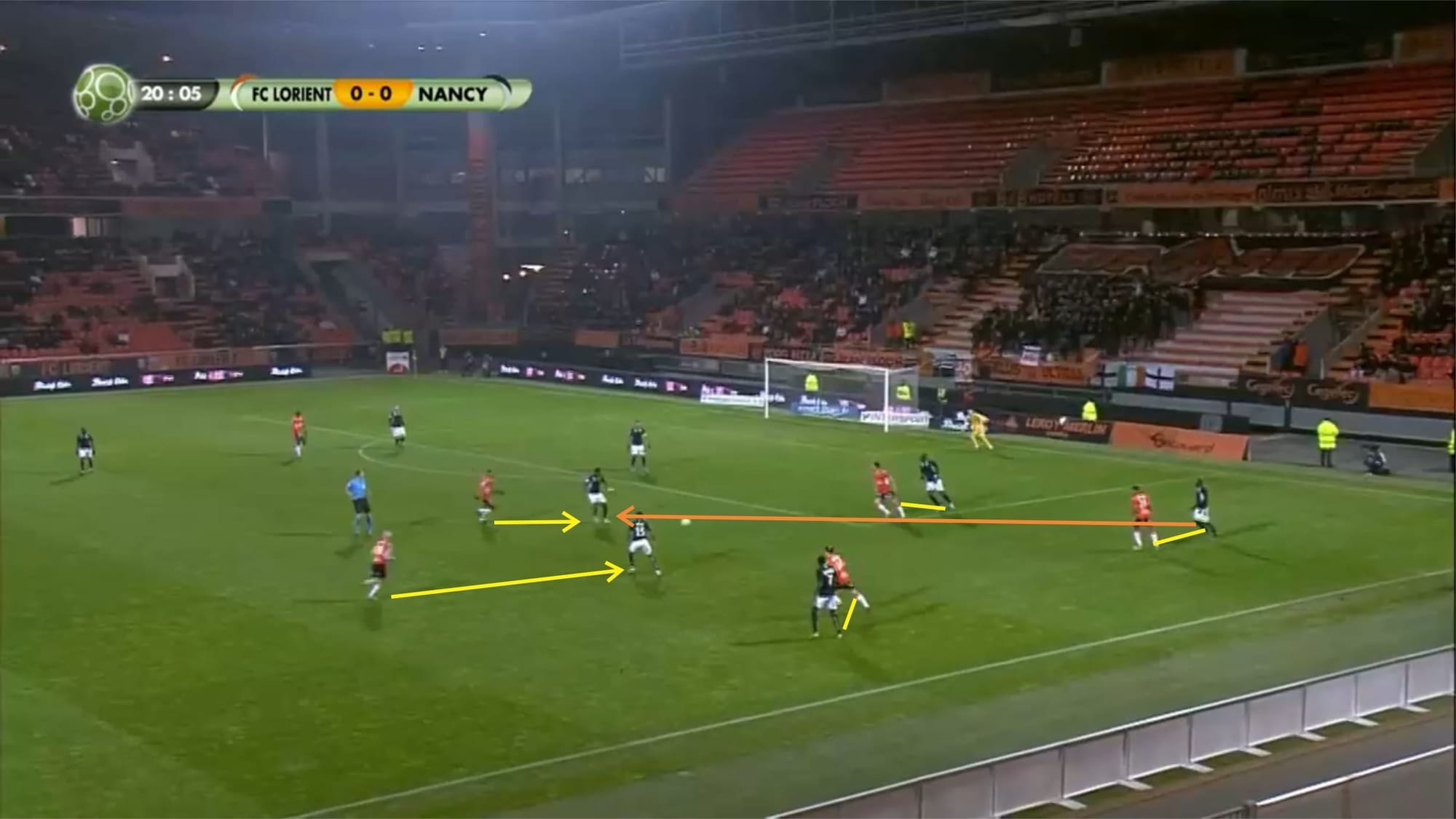
Meanwhile, after losing possession, Lorient will quickly counter-press instead of sitting back. Their main aim is to be to delay the opposing team’s counter-attack with a view to winning the ball back if there’s an opportunity to do so. In the image above, for example, Nancy won the ball back and tried to progress forward quickly on the counter. You can see that one Lorient player pressed the ball receiver when the ball was played towards him while the others quickly move closer and marked the near options, effectively limiting the ball receiver’s options.
Usually, the presser will engage the ball carrier in a 1v1 duel and shadow his movements while tightening his space and forcing him to make decisions instead of immediately committing and trying to win the ball. In certain situations, however, pressing the ball carrier aggressively and committing to the ball will also be a very good decision (as in the image above for example), especially if the ball carrier is unable to receive the ball comfortably or unable to control the ball properly. It’s all about doing the right thing at the right situation for Lorient. Their aggressive, yet also seemingly patient approach in here seems to work effectively in limiting the opposing team’s threats on the counter.
Conclusion
Pélissier’s side have certainly been brilliant in Ligue 2 in the 2019/20 season and their promotion to Ligue 1 is unequivocally deserved judging by their performance so far albeit the season not ending properly due to the current situation. They have been extremely solid in attack and defence, becoming the most prolific team in the league with 45 goals scored as well as being the fourth-lowest in terms of goals conceded with only 25 goals scored against them.
Lorient’s patient but fluid possession-based approach accompanied with highly effective finishing upfront has brought them success this season. But aside from that, their high aggression and intensity in defence and transitions certainly have gone unnoticed as well. In Ligue 2, Lorient become the team that would come into the game to dominate possession but can they do the same against superior sides in Ligue 1? We certainly would like to see that happen.





Comments